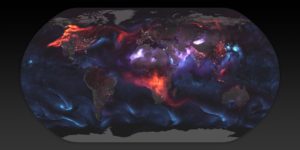
Recently, I visited the Museum of Capitalism exhibit at SMFA. Among the pieces on display, there was an interactive sculpture titled “The Minimum Wage Machine”, which invited folks to crank a handle to churn out one penny every four seconds – or, $9/hour.
Since the piece sits in a gallery within a university, I think the audience of this piece might be students, academics, and folks wanting (and able) to seek out art. Not everyone has the time, mobility, or financial resources to make the trip out to this gallery, and not everyone might know about or be the target market for the SMFA. I only happened to stumble upon this gallery when I was trying to get to the SMFA store, and likely wouldn’t have known about it otherwise. I would also guess that the audience of this piece is folks who do not earn minimum wage.
I think the goal of this presentation is to create a personal connection and understanding of the minimum wage. By inviting active participation with the body through the use of the hand crank, the artist creates an embodied understanding of what it means to earn $9/hour through active work (rather than purely an intellectual one). There is also a temporal element of this presentation – in order to “make” the hourly wage, the viewer understands that they would need to stand there and crank the machine for a full sixty minutes; the time it takes to earn $9 is also embodied. I also think that, by creating the base unit a single cent, this presentation also aimed to emphasize how low the minimum wage is. A penny is generally understood to be low value, and by breaking down $9 into one-cent units, the artist invites viewers to think about how little money is being made.
I thought that this was an effective data presentation. I personally am very interested by kinetic communication of data/communication that involves the physical body, and thought that this presentation made the feeling of earning minimum wage relatable for anyone who saw the sculpture. I also think the piece was memorable, in part because it involved movement and touch, which also makes the presentation effective in my mind.


